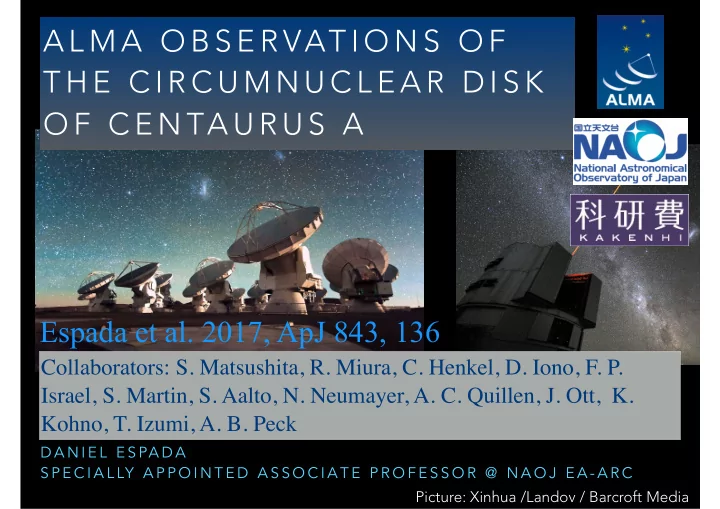

A L M A O B S E R VAT I O N S O F T H E C I R C U M N U C L E A R D I S K O F C E N TA U R U S A Espada et al. 2017, ApJ 843, 136 Collaborators: S. Matsushita, R. Miura, C. Henkel, D. Iono, F. P. Israel, S. Martin, S. Aalto, N. Neumayer, A. C. Quillen, J. Ott, K. Kohno, T. Izumi, A. B. Peck D A N I E L E S PA D A S P E C I A L LY A P P O I N T E D A S S O C I A T E P R O F E S S O R @ N A O J E A - A R C Picture: Xinhua /Landov / Barcroft Media
C E N TA U R U S A ( N G C 5 1 2 8 ) - Closest radio-powerful source and Elliptical galaxy, D~3.8 Mpc (1’’ = 18pc) - Dust lane. Gaseous disk was likely accreted by a merger event - Large scale and collimated jet - Supermassive black hole: ~6x10 7 Mo
SMA CO(2-1), 6’’ Chandra X-ray Spitzer 8um CND 400 pc Circumnuclear Disk (CND) • Size 400 pc x 200 pc, inclination ~60deg • Perpendicular to the jet (at least in projection) • Rapidly rotating, ~450 km/s (FWZI) • Molecular gas mass M gas, CND = 8 × 10 7 Mo Espada+09, 10, 12 • No CO emission in inner 100 pc???
F R O M K P C D O W N T O P C S C A L E ? Molecular properties in the CND -> torus Is CO depleted in the inner ~100 pc? Mechanism feeding the AGN ALMA observations H2 (1-0) S(1) VLT/SINFONI CO(3-2), HCO+(4-3), Neumayer+07 HCN(4-3), CO(6-5) ~0.3’’ (5pc) < 6mJy/beam in 20 km/s 2012.1.00225.S (PI. Espada)
M U LT I - P H A S E C N D O F C E N TA U R U S A Ring Nuclear filaments ALMA CO(3-2) ALMA CO(6-5) NIR H2 2.12um
50 pc
F I T T I N G T H E C N D W I T H C O N C E N T R I C R I N G S Incl (deg) ALMA CO3-2 Offset (arcsec) VLT H 2 SMA CO2-1 Spitzer MIR cont. PA kin (deg) Offset (arcsec) V (km/s) But k5/k1 is unrealistically large (>0.2) => non-circular motions, kinematically distinct components log(r) (pc)
I N T E R FA C E C O A N D WA R M H 2 CO nuclear filaments or 108 pc shocks Shock fronts • Regions bright in warm H2 are not present in CO(3-2), CO(6-5) (nor HCN(4-3), nor HCO+(4-3))
W H AT I S T H E M E C H A N I S M AT P L AY ? Ring, nuclear filaments (180 At large scale: warped disk deg rotational symmetry, perturbed by non- steeper PV curve) axisymmetric potential Espada+09 Espada+17
H C O + ( 4 - 3 ) A N D H C N ( 4 - 3 ) - No HCO+(4-3) HCN(4-3) emission in the inner ~30pc - HCN / HCO+ (4-3) <~ 0.5
� � NGC7469 CenA Izumi+15 • Dense gas tracer ratios used to identify whether AGN or SB • HCN/HCO+ > 1 in low luminosity AGNs, likely because mechanical heating � • But in Cen A’s molecular clouds just ~30 pc away, HCN/HCO+ <~0.5
S U M M A RY • CND of CenA present a network of molecular filaments of ~100 pc, spiral features and streamers. • Ring like structure + nuclear filaments (shocks! ) resemble gas under non-axisymmetric potential • Chemistry in molecular clouds in CND is peculiar. HCN/HCO +<1 even close to the AGN, unlike low luminosity AGNs . Is it dominated by XDR, time variation? • The nuclear disk seen in warm H2 (~1000K), not CO, HCN, and HCO+ transitions. No cold nuclear disk as opposed to simulations? • Overall distribution and kinematics show several shocks at different scales caused by non-circular motions (due to warp itself? or stellar component?)
T H A N K S !
Recommend
More recommend